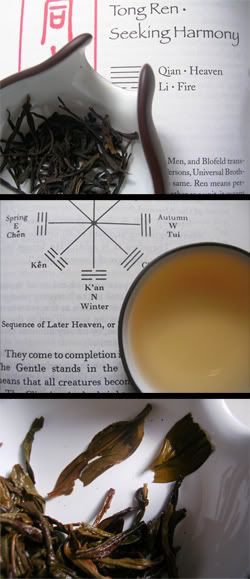This is the second grade of baxian from Royal Tea Garden, which costs £8/100g, and claims organic status. [Many thanks to CB for the sample.]
Brita-filtered water @ 90C in 10cl dancong pot; ~5g leaf; 1 rinse
 Dry leaf:
Dry leaf:3-5cm dark, twisted leaves with one or two small, flat leaves (also oxidised to dark brown). The aroma is that of sweet grapes.
The soup is a concerningly pale yellow-and-green, and this fear is born out in the aroma and flavour which are fairly quiet.
In its beidixiang, it is very much a gaoshan wulong: buttery, with just the right amount of roasting making its way into the scent. The fruity finish beloved of dancong fans appears as regular as clockwork in the lengxiang, and pleasant it is.
"So fresh! It has a herb-like character." The conjunction of fruits and roasting does provoke the impression of the more floral herbs, such as thyme and rosemary.
"Too light - insipid." The tea doesn't carry well into the later infusions. It is gentle, sweet, floral, but ultimately fairly mundane.
Wet leaves:
Fragile and hard to unroll, I wonder if these are summer leaves, further suggested by their size. They are quite green, and the oxidation level is constant across the surface of the leaf, rather than being bruise-oxidised at the edges and stem.
Overall:
I wonder if the roasted-fruitiness is signature baxian - I simply have not encountered enough to create a firm prior image of this type of dancong.
It is a refreshing mixture of gaoshan wulong with a good roast, but doesn't excite too much enthusiasm.

Do the 8 immortals and the 8 trigrams correspond, I wonder?
ReplyDeleteI suspect the floral/fruity character is signature BaXian. I compared this brewed side-by-side with a BaXian from Jing. The Jing BaXian dry leaf was much greener, with the leaves more open, and smelling more vegetal than roasted. Clearly the processing was very different than the RTG, yet I found both very floral. In the Jing tea the floral was a light, beautiful honeysuckle. The RTG was similarly floral but more mature somehow, sweeter, heavier, and accompanied by the daker roasted flavors. Both teas had their merits. And I agree that the RTG plays out its best qualities in the first infusion.
Some great knowledge - thank you, Carla! I would really love to know what general characteristics a producer has in mind when he sets out to make a certain type of dancong. There are so many varieties! I sincerely wonder if anyone could correctly do a blind separation of all of the dancong: milanxiang, huangzhixiang, songzhong, baiye, "shuixianxiang", xingren, yulan, &c., &c...
ReplyDeleteI really want to thank you again for providing the samples for this comprehensive tour of dancong territory - just one more remains to be tried!
Toodlepip,
Hobbes
Also, some more information on the Chinese folklore surrounding the Baxian can be found at Wikipedia.
ReplyDeleteToodlepip,
Hobbes
Dear Carla,
ReplyDeleteOne of the eight immortals, Lu Dongbin, is supposed to have written the Taiyi Jinhua Zongzhi [太一金华宗旨 - "The Secret of the Golden Flower"], one of my favourite texts. I'm sure you'd enjoy reading it, as a yogi and someone interested in the philosophy of the Yijing. Richard Wilhelm's translation is the classic (much like his Yijing, of course).
Toodlepip,
Hobbes
Back on the subject of Baxian, Jing teashop talks about the "Baxian yun" [Baxian sensation] in its product description of an Anxi Baxian (not a dancong):
ReplyDelete"The tea leaves have been baked with wood charcoal fire which offers this lovely oolong tea a pleasant honey touch.
The liquor is thick and shiny with a very good clarity. The heavy liquor is very rich and complex, yet smooth. Because of the long time and low temperature wood charcoal baking, this oolong tea gives a honey like sweetness to the mouth with some grapefruit flower notes in the finish. The 'Ba Xian Yun' is rather obvious during the aftertaste, which is slightly astringent combined with a delicate creamy hint."
It's not clear what the "Baxian yun" is, here - perhaps the "slightly astringent [aftertaste]" with the "delicate creamy hint"? I didn't find those details in the RTG sample, though.
Toodlepip,
Hobbes
Hobbes,
ReplyDeleteThank you for the reading suggestion - it's on my list of books to purchase.
The Jing BaXian I was tasting was
this one, the 2006 Winter FengHuang Single Bush DanCong.
I agree it's not clear what the "BaXian Yun" refers to. All I know is that the few BaXians I've tasted (probably could count these on one hand) have had a marked floral character, but I can't even swear that I could differentiate it from, say, the DanCong MiLans in a blind taste test. Perhaps with some more practice...?
I suspect there isn't any real correspondence between the 8 trigrams and the 8 immortals; it was just a thought. Only one woman in the whole lot of them, (unless you count the gender-neutral Lan Caihe as female) and she's got to be a virgin to be pure enough to qualify! Alas.